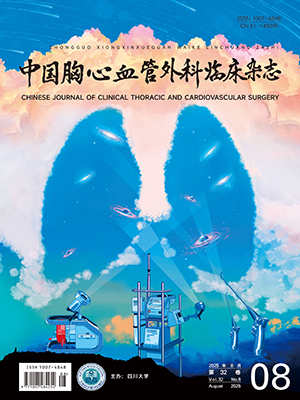Objective To investigate the effects of ischemic postconditioning (IPO) on inflammatory response inischemia-reperfusion (IR) injury of rat lungs in vivo. Methods Forty SD rats were randomly divided into 5 groups inclu-ding a sham surgery group (S group),a 30-minute IR group (I/R-30 group),a 120-minute IR group(IR-120 group),a 30-minute IPO group (IPO-30 group),and a 120-minute IPO group (IPO-120 group). There were 8 rats in each group. All therats received left thoracotomy after anesthesia. In the sham surgery group,a line was only placed around the left hilum butnot fastened. In the I/R-30 group and I/R-120 group,a line was fastened to block the blood flow of the left lung for 1 hour,then loosened for reperfusion for 30 minutes and 120 minutes respectively. In the IPO-30 group and IPO-120 group,afterblocking the blood flow of the left lung for 1 hour,the left hilum was fastened for 10 seconds and loosened for 10 seconds(repeating 3 times for 1 minute),then the line was loosened for 30 minutes and 120 minutes respectively. The levels of interleukin-10 (IL-10) in lung tissues and soluble intercellular adhesion molecule-1 (sICAM-1) in plasma were measured. Histopathological changes of lung tissues were observed and diffuse alveolar damage (DAD) scores was calculated.Results The levels of plasma sICAM-1 in the I/R-30 group and I/R-120 group were significantly higher than that of S group [(2.140±0.250)μg/L vs. (0.944±0.188)μg/L,P=0.003;(2.191±0.230)μg/L vs. (0.944±0.188)μg/L,P=0.003]. IL-10levels in lung tissues in the I/R-30group and I/R-120 group were also significantly higher than that of S group[(15.922±0.606)pg/mg pro vs. (7.261±0.877)pg/mg pro,P=0.037;(17.421±1.232)pg/mg pro vs. (7.261±0.877)pg/mg pro,P=0.042]. Pathologic lesions of lung tissues in the I/R-30 group and I/R-120 group were more severe than that of S group. After IPO, plasma sICAM-1 levels in the IPO-30 group and IPO-120 group were significantly lower than those in the I/R-30group and I/R-120 group respectively [(1.501±0.188)μg/L vs.(2.140±0.250)μg/L,P=0.038;(1.350±0.295)μg/L vs.(2.191±0.230)μg/L,P=0.005]. IL-10 levels in lung tissues in the IPO-30 group and IPO-120 group were significantly higherthan those in the I/R-30 group and I/R-120 group respectively [(20.950±1.673)pg/mg pro vs.(15.922±0.606)pg/mgpro,P=0.008;(25.334±1.173)pg/mg pro vs.(17.421±1.232)pg/mg pro,P=0.006]. DAD scores in the IPO-30 group andIPO-120 group were significantly lower than those in the I/R-30 group and I/R-120 group respectively [6.8±1.4 vs. 11.5±1.9,P=0.007;7.5±1.6 vs. 13.2±1.7,P=0.005]. Pathological lesions of the lung tissues of IPO groups were less severe than those of I/R groups. Conclusion IPO can attenuate IR injury by inhibiting inflammatory response in rat lungs.
Citation: DUAN Mingke,MA Limin,LAN Junbin,WU Yigen,XIONG Wei,GAO Yizhe,XU Shengshui.. Effects of Ischemic Postconditioning on Inflammatory Response in Ischemia-Reperfusion Injury of Rat Lungs in Vivo. Chinese Journal of Clinical Thoracic and Cardiovascular Surgery, 2013, 20(6): 705-709. doi: 10.7507/1007-4848.20130215 Copy
Copyright © the editorial department of Chinese Journal of Clinical Thoracic and Cardiovascular Surgery of West China Medical Publisher. All rights reserved
-
Previous Article
Actuality and Progress of Treatment for Ductal Carcinoma in Situ -
Next Article
食管癌术后迟发膈疝一例




